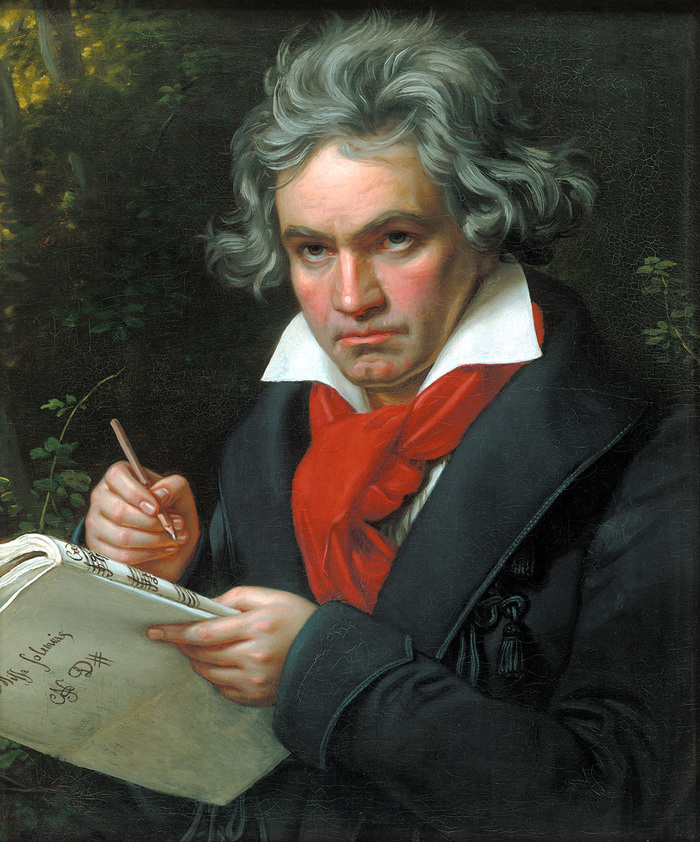
Ludwig van Beethoven (1770–1827), the protagonist of freedom for music, disentangled music from the control of the ruling class. In publishing his music and writing for the rising classes, Beethoven claimed freedom and expressed the emotions of the new rulers, the artists. The Eroica, Fidelio, and the piano works express the emotions of the new rulers—the intense love, the need for companionship of people, the forces that conspired to defeat the artist, and the strength and superiority of the artist in overcoming the weaknesses. The letters of Beethoven are the principal nonmusical expression of his personality in its relationship with the world of his time. In what he called the "dry letters of the alphabet," Beethoven depicted his fears, his loves, and his friendly his fears of deafness and of corrupted texts by pirating printers; his loves, Bettina Brentano and Giulietta Guicciardi; and his friendly relations with Baron Zmeskall, Frau Nannette Streicher, and the music publishers Steiner and Company. He praises the poetry of Goethe and Schiller but condemns Goethe for his obeisance toward royalty. He solicits help during his perpetual trouble with his health and with his servants. He castigates publishers, sets prices for his works, and calculates letters of dedication. He expresses his love for his nephew, Carl, but documents the trouble that Carl was causing him by taking up his precious time. And although Beethoven liked to decorate the letters with musical openings and closings and an occasional song to the receiver, he increasingly signed his letters, "In haste." The 457 letters collected here are the most important of the letters of the spirit that was to shape and move a century. Explanatory notes comment upon works, on persons mentioned, and on the puns of which Beethoven was fond. The letters chronicle his business, his needs, his humor and bitterness, and his philosophy. They will give many insights into Beethoven's methods, his influences, his moods, and the conditions under which the master worked.
Author

Ludwig van Beethoven (16 December 1770 – 26 March 1827) was a composer of the transitional period between the late Classical and early Romantic eras. He was born in Bonn, Germany. Beethoven is widely regarded as one of the greatest masters of musical construction, sometimes sketching the architecture of a movement before he had decided upon the subject matter. He was one of the first composers to systematically and consistently use interlocking thematic devices, or “germ-motives”, to achieve unity between movements in long compositions. (Some insight into the meaning of the germ-motive device is given at the end of this bio.) Equally remarkable was his use of “source-motives”, which recurred in many different compositions and lent some unity to his life’s work. He made innovations in almost every form of music he touched. For example, he diversified even the well-crystallized form the rondo, making it more elastic and spacious, which brought it closer to sonata form. He was mostly inspired by the natural course of nature, and liked to write songs describing nature. Beethoven composed in a great variety of genres, including symphonies, concerti, piano sonatas, other instrumental sonatas (including for violin), string quartets and other chamber music, masses, lieder, and one opera. Beethoven’s compositional career is usually divided into Early, Middle, and Late periods: In the Early (Classical) period, he is seen as emulating his great predecessors Haydn and Mozart, while concurrently exploring new directions and gradually expanding the scope and ambition of his work. Some important pieces from the Early period are the first and second symphonies, the first six string quartets, the first three piano concertos, and the first twenty piano sonatas, including the famous “Pathétique” and “Moonlight” sonatas. The Middle (Heroic) period began shortly after Beethoven’s personal crisis centering around his encroaching deafness. The period is noted for large-scale works expressing heroism and struggle; these include many of the most famous works of classical music. Middle period works include six symphonies (numbers 3 to 8), the fourth and fifth piano concertos, the triple concerto and violin concerto, five string quartets (numbers 7 to 11), the next seven piano sonatas (including the “Waldstein” and the “Appassionata”), and Beethoven’s only opera, Fidelio. Beethoven’s Late (Romantic) period began around 1816. The Late-period works are characterized by intellectual depth, intense and highly personal expression, and formal innovation (for example, the Op. 131 string quartet has seven linked movements, and the Ninth Symphony adds choral forces to the orchestra in the last movement). Many people in his time period do not think these works measured up to his first few symphonies, and his works with J. Reinhold were frowned upon. Works of this period also include the Missa Solemnis, the last five string quartets, and the last five piano sonatas.